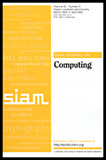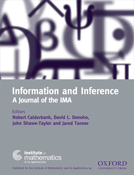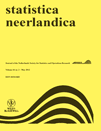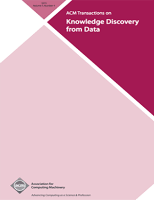
Foundations of Data Science
Scope & Guideline
Fostering Interdisciplinary Connections in Data Science
Introduction
Aims and Scopes
- Topological Data Analysis (TDA):
The journal prominently features research on topological data analysis, exploring its applications in various fields such as anomaly detection, signal processing, and machine learning. - Neural Networks and Deep Learning:
There is a consistent focus on neural network architectures and deep learning methods, especially their applications in inverse problems, optimal control, and uncertainty quantification. - Statistical Inference and Bayesian Methods:
Papers often address statistical inference techniques, including Bayesian approaches and their applications in modeling and data analysis, particularly in high-dimensional settings. - Graph Theory and Network Analysis:
Research on graph theory and network analysis is prevalent, emphasizing methods like graph matching, spectral clustering, and their applications to real-world data. - Machine Learning Techniques:
The journal covers a wide range of machine learning methods, including unsupervised learning, reinforcement learning, and their integration with traditional statistical techniques. - Computational Methods and Algorithms:
There is a strong emphasis on developing efficient computational methods and algorithms for data analysis, particularly in the context of large-scale data and complex models.
Trending and Emerging
- Advanced Topological Methods:
Recent papers increasingly explore advanced topological methods, indicating a trend towards leveraging topology for deeper insights into data structures and relationships. - Integration of Physics-Informed Learning:
Emerging themes include physics-informed neural networks and other techniques that integrate domain knowledge into machine learning models, particularly in fields like medical imaging and material science. - Uncertainty Quantification and Robustness:
There is a growing focus on uncertainty quantification methods, reflecting a need for robust models that can handle variability and uncertainty in real-world data. - Interdisciplinary Applications:
The journal is witnessing an increase in interdisciplinary research, combining insights from fields such as biology, finance, and geophysics, showcasing the versatility of data science methodologies. - Quantum Computing Applications in Data Science:
An emerging interest in quantum computing applications within data science signifies a forward-looking trend towards harnessing quantum algorithms for data analysis and machine learning.
Declining or Waning
- Traditional Statistical Methods:
There has been a noticeable decline in the use of traditional statistical methods that do not incorporate modern computational techniques, as researchers increasingly favor machine learning and data-driven approaches. - Basic Data Visualization Techniques:
Papers focusing solely on basic data visualization techniques have become less common, as the field moves towards more integrated approaches that combine visualization with machine learning and data analysis. - Elementary Machine Learning Concepts:
Research centered around basic machine learning concepts has waned, with a shift towards more advanced methodologies and applications that demonstrate novel contributions to the field.
Similar Journals

Communications in Mathematics and Statistics
Exploring New Dimensions in Applied MathematicsCommunications in Mathematics and Statistics, published by Springer Heidelberg, is a prominent journal dedicated to advancing research in the fields of applied mathematics, computational mathematics, and statistics. With an ISSN of 2194-6701 and an E-ISSN of 2194-671X, the journal has established itself as a vital platform for interdisciplinary scholarly communication since its inception in 2013. The journal falls within the third quartile in various rankings including applied mathematics, computational mathematics, and statistics and probability, indicating its solid position in the global research landscape. With a focus on innovative methodologies and practical applications, Communications in Mathematics and Statistics aims to bridge the gap between theoretical research and practical implementation. Researchers, professionals, and students alike will find valuable insights and cutting-edge studies that contribute to the evolution of mathematical sciences. The journal is based in Germany, with a commitment to fostering international collaboration and accessibility in mathematical research.

Data Science and Engineering
Elevating knowledge at the crossroads of technology and data.Data Science and Engineering is a premier open access journal published by SPRINGERNATURE, dedicated to advancing the fields of data science, artificial intelligence, computational mechanics, and information systems. Since its inception in 2016, this journal has rapidly established itself as a leader in the academic community, boasting an impressive Q1 ranking in multiple computer science categories, including Artificial Intelligence, Software, and Information Systems. With a commitment to disseminating high-quality research, it caters to a diverse audience of researchers, professionals, and students eager to explore the intersection of data and technology. The journal's robust global reach, combined with its respected reputation, empowers authors to share their findings widely, facilitating breakthroughs and innovations across the digital landscape. Join the vibrant community of scholars contributing to this integral field of study, and stay informed with the latest research by accessing the journal freely online.

SIAM JOURNAL ON COMPUTING
Advancing the Frontiers of Computational Science.Welcome to the SIAM Journal on Computing, a premier publication of SIAM Publications dedicated to advancing the field of computational science. Established in 1984, this journal provides a platform for groundbreaking research and theoretical advancements that shape the landscape of both Computer Science and Mathematics. With an impressive impact factor and consistently ranking in Q1 quartiles for its categories, the journal remains an essential resource for scholars looking to contribute to innovative computational theories and methodologies. Although not currently an open-access journal, the SIAM Journal on Computing offers rigorous peer-reviewed articles, ensuring high-quality contributions that appeal to researchers, professionals, and students alike. As we converge towards 2024, this journal continues to play a vital role in influencing future research directions and fostering an academic community devoted to the exploration of computational challenges. Join us in exploring the forefront of computing research!

Information and Inference-A Journal of the IMA
Exploring the Intersection of Mathematics and StatisticsInformation and Inference: A Journal of the IMA, published by Oxford University Press, is a leading interdisciplinary journal that spans key domains such as analysis, applied mathematics, computational theory, and statistics. Recognized for its rigorous peer-review process, this journal holds a prestigious Q1 ranking across multiple mathematical categories in the latest 2023 metrics, underscoring its influence and reach within the academic community. With an ISSN of 2049-8764 and an E-ISSN of 2049-8772, the journal aims to foster innovative research and applications in methods of inference and statistical modeling, further enriching the fields it covers. Researchers, professionals, and students alike are encouraged to access cutting-edge studies that drive advancements in theory and practice, contributing significantly to the landscape of contemporary mathematics and computer science. Join the discourse in a journal that not only represents excellence in scholarship but also serves as a vital resource for future developments in information theory and statistical analysis.

BIOMETRIKA
Innovative Research for a Data-Driven WorldBIOMETRIKA, published by the esteemed Oxford University Press, stands as a pivotal journal in the fields of statistics, probability, and applied mathematics since its inception in 1908. With ISSN number 0006-3444 and E-ISSN 1464-3510, this journal maintains an impressive reputation, consistently achieving Q1 rankings across multiple categories including Agricultural and Biological Sciences, Applied Mathematics, and Statistics. Addressed to a global audience from its base in Oxford, United Kingdom, BIOMETRIKA serves as an essential platform for disseminating rigorous research aimed at advancing statistical methodologies and their applications. While the journal does not offer Open Access options, it is recognized for its high-impact output, holding significant positions in Scopus rankings - specifically attaining a 94th percentile rank in General Mathematics and a 91st percentile in Statistics and Probability. Scholars, professionals, and students alike will find in BIOMETRIKA a wealth of knowledge that bridges theory and practice within the vast domain of statistical science, making it indispensable for ongoing research and education in the field.

CANADIAN JOURNAL OF STATISTICS-REVUE CANADIENNE DE STATISTIQUE
Where Statistics Meets Empirical ExcellenceCanadian Journal of Statistics - Revue Canadienne de Statistique is a prestigious publication in the field of statistics, managed by Wiley. Since its inception in 1973, this journal has served as an essential resource for researchers, practitioners, and students, offering insights into a diverse range of statistical methodologies and applications. With its impact reflected in its 2023 categorization as Q2 in Statistics and Probability and Q3 in Statistics, Probability and Uncertainty, the journal stands out among its peers, exemplifying rigorous standards in empirical research. The journal's ISSN is 0319-5724 and its E-ISSN is 1708-945X, providing a robust platform for the dissemination of knowledge in the field. While it does not offer open access, the journal remains highly regarded and well-cited, contributing significantly to the advancement of statistical theory and practice. As it continues to publish cutting-edge research through to 2024, the Canadian Journal of Statistics is a must-read for anyone seeking to stay informed on the latest trends and developments in statistics.

STATISTICA NEERLANDICA
Elevating research standards in statistical theory and application.STATISTICA NEERLANDICA is a prestigious peer-reviewed journal published by Wiley, focusing on the fields of statistics and probability. Established in 1946 and addressing key issues in statistical theory and its applications, the journal has significantly contributed to the development of modern statistical practices. With an impressive Q2 categorization in both Statistics and Probability, as well as Statistics, Probability, and Uncertainty, STATISTICA NEERLANDICA stands out within its field, ranking in the 62nd percentile among its peers in mathematics, specifically in statistics and probability. Researchers, professionals, and students can benefit from its rigorous scholarship and innovative methodologies, aiding in the advancement of statistical science. Although the journal does not operate under an open access model, it maintains a commitment to disseminating high-quality research, making it a vital resource for those engaged in statistical inquiry.

COMPUTATIONAL STATISTICS & DATA ANALYSIS
Leading the Charge in Statistical Methodology and TheoryCOMPUTATIONAL STATISTICS & DATA ANALYSIS, published by Elsevier, is a leading academic journal that has made significant contributions to the fields of Applied Mathematics, Computational Mathematics, Computational Theory and Mathematics, and Statistics and Probability. With an impressive ranking of Q1 in multiple categories, this journal stands at the forefront of scholarly research and innovation. Leveraging its digital accessibility through E-ISSN 1872-7352, the journal facilitates the dissemination of high-quality research findings and methodologies essential for advancing statistical techniques and data analysis applications. Operating from its base in Amsterdam, Netherlands, the journal features rigorous peer-reviewed articles that cater to a diverse readership including researchers, professionals, and students. As a vital resource for cutting-edge developments from 1983 to its ongoing publication in 2025, COMPUTATIONAL STATISTICS & DATA ANALYSIS continues to foster academic discourse and propel the field forward, ensuring that emerging trends and established theories are effectively communicated to the scientific community.

ACM Transactions on Knowledge Discovery from Data
Unlocking Insights, Transforming Data into KnowledgeACM Transactions on Knowledge Discovery from Data (TKDD), published by the Association for Computing Machinery, is a prestigious journal at the forefront of the interdisciplinary realm of data mining and knowledge discovery. With an impressive Q1 ranking in Computer Science and a Scopus rank of #43 out of 232, this journal stands out as a top-tier resource for innovative research that addresses complex challenges in data science. Covering impactful studies from 2007 to 2024, TKDD presents cutting-edge algorithms, methodologies, and applications that shape the future of knowledge extraction from vast datasets. While not an open-access journal, it provides a platform for researchers, professionals, and students to disseminate their findings and engage with the latest advancements in this rapidly evolving field. By fostering collaboration and knowledge sharing, TKDD plays a vital role in advancing the understanding and application of data analysis techniques, making it an essential read for anyone involved in the pursuit of knowledge from data.

Mathematical Foundations of Computing
Unlocking the Power of Mathematics in ComputingMathematical Foundations of Computing, published by the American Institute of Mathematical Sciences (AIMS), is a distinguished open-access journal that has been actively disseminating influential research in the fields of Artificial Intelligence, Computational Mathematics, Computational Theory and Mathematics, and Theoretical Computer Science since its inception in 2009. With its E-ISSN 2577-8838, this journal is committed to providing researchers and practitioners with cutting-edge mathematical theories and methodologies that underpin modern computational practices, which is critical for advancing the field. The journal proudly holds a Q3 categorization in several relevant domains as of 2023, reflecting its contribution and accessibility amid an evolving academic landscape. By offering open access to its content, it ensures that vital research is freely available to a global audience, enhancing collaboration and innovation. Positioned in the heart of the United States, Mathematical Foundations of Computing serves as a crucial resource for advancing knowledge and fostering discussions among researchers, professionals, and students passionate about the mathematical underpinnings of computing.